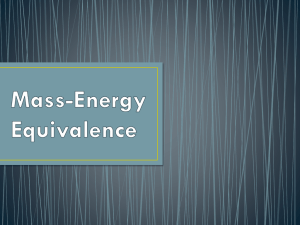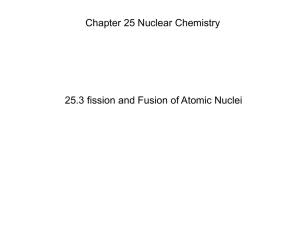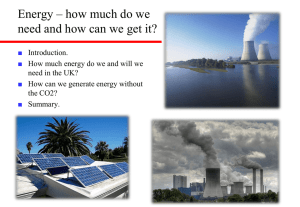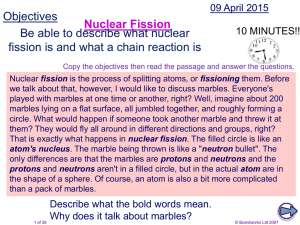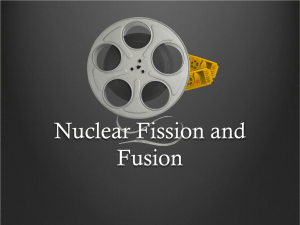5. Nuclear Fission_BNEN_Intro_2012-2013
advertisement
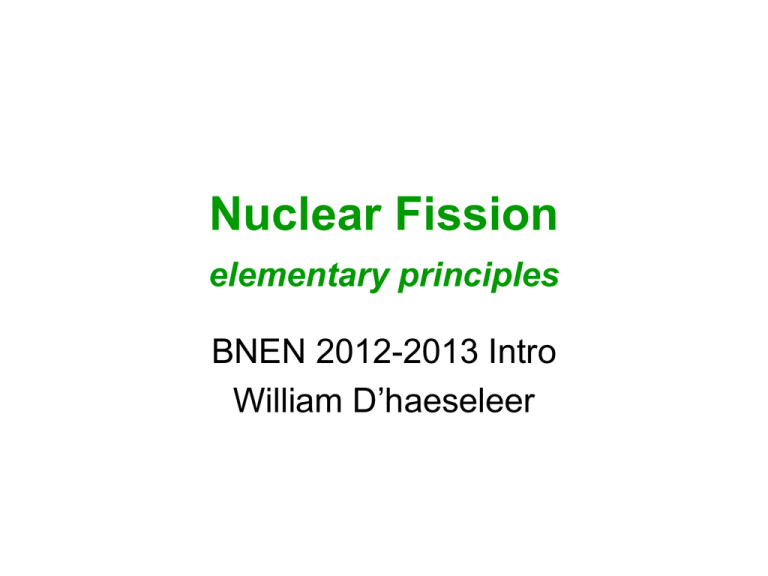
Nuclear Fission elementary principles BNEN 2012-2013 Intro William D’haeseleer Mass defect & Binding energy ΔE = Δm c2 Nuclear Fission • Heavy elements may tend to split/fission • But need activation energy to surmount potential barrier • Absorption of n sufficient in 233U 235U 239Pu … fissile nuclei • Fission energy released ~ 200 MeV • Energetic fission fragments • 2 à 3 prompt neutrons released upon fission Nuclear fission Nuclear Fission + products Ref: Duderstadt & Hamilton Practical Fission Fuels 1 0 n A1 z X Az X → fission Ref: Lamarsh NRT fissile U-233 fissile U-235 fissile Pu-239 BNEN NRT 2009-2010 William D’haeseleer 6 Practical Fission Fuels From these, 235 only 92 U appears in nature (0.71%) The other fissile isotopes must be “bred” out of out of Th-232 U-238 (for U-233) (for Pu-239) 7 Practical Fission Fuels Fertile nuclei Nuclei that are not easily “fissile” (see further) but that produce fissile isotopes after absorption of a neutron 8 Practical Fission Fuels * Thorium-uranium n 23290Th + 23390Th 1 0 β (22 min) 233 91 - not much used so far - but large reserves of Th-232 Pa β (27 d) 233 92 U Fissile by slow (thermal) neutron - new interest because of ADS (cf. Rubbia) 9 Practical Fission Fuels * Uranium-Plutonium 239 n 238 U + 92 92 U 1 0 β (23 min) 239 93 Np β (2.3 d) - up till now mostly used for weapons - is implicitly present in U-reactors - now also used as MOX fuels 239 94 Pu Fissile by slow (thermal) neutron - the basic scheme for “breeder reactors” 10 Practical Fission Fuels Fissionable nuclei Th-232 and U-238 fissionable with threshold energy U-233, U-235 & Pu 239 easily fissionable = “fissile” -- see Table 3.1 -11 Practical Fission Fuels 1 0 n A1 z X Az X → fission Eth=1.4 MeV Th-232 fissionable U-238 fissionable Eth=0.6MeV BNEN NRT 2009-2010 William D’haeseleer 12 Fission Chain Reaction Chain reaction 235 U Fission Chain Reaction • k= multiplication factor • k= (# neutrons in generation i) / (# neutrons in generation i-1) • k= 1 critical reactor • k>1 supercritical • k<1 subcritical Critical mass • Critical mass is amount of mass of fissile material, such that Neutron gain due to fission = Neutron losses due to leakage & absorption • Critical mass = minimal mass for stationary fission regime Probability for fission Logarithmic scale ! Comparison fission cross section U-235 and U-238 [Ref Krane] BNEN NRT 2009-2010 William D’haeseleer 16 Cross Section of Fissionable Nuclei • Thermal cross section Important for “fissile” nuclei, is the so-called thermal cross section at 0.025 eV th f -- See Table 3.2 -17 Cross Section of Fissionable Nuclei 18 Cross Section of Fissionable Nuclei • Absorption without fission σγ for these nuclei ~ other nuclei behaves like 1/v for small v at low En, inelastic scattering non existing only competition between -fission -radiative capture 19 Cross Section of Fissionable Nuclei Define capture to fission ratio f 20 Cross Section of Fissionable Nuclei α > 1 more chance for radiative capture U-235 α < 1 more chance for fission 21 Cross Section of Fissionable Nuclei f Note a f 22 Cross Section of Fissionable Nuclei Then with f Relative probability fission = f 1 f 1 Relative probability rad. capture = f 1 23 Thermal reactors • Belgian fission reactors are “thermal reactors” • Neutrons, born with <E>=2MeV to be slowed down to ~ 0.025 eV • By means of moderator: – Light material: hydrogen, deuterium, water graphite Fission products / fragments Fission products / fragments Fission products / fragments Fission products / fragments Fission products / fragments Fission products generally radioactive Dominantly neutron rich Mostly β- decay The products of fission: neutrons → Besides fission also absorption capture to fission ratio Recall f In U-235: 15% for low En 1 Therefore: f v v a 1 See table 3.2 f η=number of n ejected per n absorbed in the “fuel” 30 The products of fission: neutrons f v v a 1 31 The products of fission: neutrons f v v a 1 η(E) for U-233, U-235, Pu-239 & Pu-241 Ref: Duderstadt & Hamilton BNEN NRT 2009-2010 William D’haeseleer 32 The products of fission: neutrons f v v a 1 To be compared with curve for α (cfr before) 33 Ref: Duderstadt & Hamilton The products of fission: neutrons η usually also defined for mixture U-235 and U-238 v(25) f (25) a (25) a (28) f i Ni f i a i Ni a i for material i for material i 34 Enrichment • Natural U consist of 99.3% 238U & 0.7% 235U • NU alone cannot sustain chain reaction • NU in heavy water moderator D2O can be critical (CANDU reactors) • Light water (H2O) moderated reactors need enrichment of fissile isotope 235U • Typically in thermal reactors 3-5% 235U enrichment • For bombs need > 90% enrichment Production of transurans Evolution of 235U content and Pu isotopes in typical LWR Production of transurans Reactor power & burn up ● Fission Rate = # fissions per second given: a reactor producing P MW fission rate P 106 J / s ER 106 1.6 1019 J P 6.25 1018 ER 1 s P 5.4 1023 fissions/day ER Reactor power & burn up ● Burn up = amount of mass fissioned per unit time Burn up = fission rate * mass of 1 atom PA Burn up = 0.895 gram/day ER A 6.0210 gram 23 for A = 235 ; ER = 200 MeV … Burn Up = 1P gram/day ! For a reactor of 1 MW, 1 gram/day U-235 will be fissioned ! Reactor power & burn up Hence, burn up 0.895 PA gram/day ER Amount of fuel fissioned But fuel consumption is larger → because of radiative capture a Total absorption rate = fission rate f 1 fission rate Reactor power & burn up consumption rate PA 0.895 1 gram/day ER Energy “production” per fissioned amount of fuel: MWD/tonne - assume pure U-235, and assume that all U-235 is fissioned; - then: energy “production” 1MWD/g = 106 MWD/tonne - but also radiative capture only 8 x 105 MWD/tonne - but also U-238 in “fuel” in practice ~ 20 to 30 x 10³ MWD/tonne (however, recently more) ~ 50 to 60 x 103 MWD/tonne Actinide Buildup [Ref: CLEFS CEA Nr 53] Total U Total Pu 955 746 941 026 923 339 9 737 11 338 13 000 Composition of spent fuel • Typical for LWR: Fission Products [Ref: CLEFS CEA Nr 53] TOTAL 33,6 46,1 61,4 Fission Products [Ref: CLEFS CEA Nr 53] Category UOX 33 GWa/tUi Enr 3.5% Amount kg/tUi Uranium Plutonium UOX 45 GWa/tUi Enr: 3.7% Amount kg/tUi UOX 60 GWa/tUi Enr: 4,5% Amount kg/tUi 955.746 941.026 923.339 9.737 11.338 13.0 61.4 FP 33.6 46.1 TOTAL 999.083 998.464 997.739 Remainder converted to energy via E=∆m c2 Delayed neutrons • Recall 2 à 3 prompt neutrons, released after ~10-14 sec • Thermalized after ~1 μsec • Absorption after ~200 μs ~ 10-4 s • Difficult to control • Nature has foreseen solution! Delayed Neutrons • Recall β decay from some fission products Neutron emission after β decay After β decay, if energy excited state daughter larger than “virtual energy” (binding energy weakest bound neutron) in neighbor: Then n emission rather than γ emission Called “delayed neutrons” Delayed neutrons • Small amount of delayed neutrons suffices (fraction ~0.0065) to allow appropriate control of reactor • Easy to deal with perturbations
